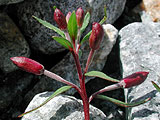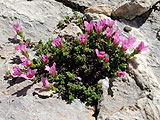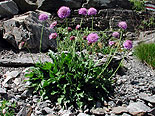 |
|
|
|
|
|
|
Size dependency Most wild plants abort many of their flowers and immature fruits. Similarly, within fruits only a fraction of ovules develop into mature seeds. Evolutionary considerations explain the role of "surplus" reproductive structures:
Adjustments to available resources play a crucial role in the abortion pattern of surplus flowers and ovules. Under alpine conditions this is particularly obvious. Particularly smaller plants are often not able to realize the potential of their reproductive structures (see Fig. 3 and 4). Environmental control of abortions At high altitudes time for fruit and seed maturation is short, but low temperatures affect histogenesis. Seeds of alpine sedges (Carex curvula, C. firma, Cyperaceae) matured within 6-8 weeks at lowland conditions instead of 7-10 weeks at high altitudes (Wagner and Reichegger 1997).
Seed to ovule ratio in outcrossing perennials is usually only between 0.4 and 0.7. Cold and other stressful conditions, i.e. dry soils as in the exceptional summer 2003 may cause increased seed abortions. Kudo and Molau (1999) observed a significant increase of aborted seeds at alpine compared to lowland sites in the legume Astragalus alpinus (Fabaceae).
|
Size controls flower and ovule numbers |
|
|
1 - Flower buds of E. fleischeri |
2 - Flowers of E. fleischeri |
|
|
3 - Increase of flower buds (left) and mean ovule number (right) with shoot size in Epilobium fleischeri.
4 - Proportion of aborted flower buds (left; I = smallest, II = medium, III = largest plants) and fate of ovules within fruits (right) in E. fleischeri. |
||
|
Short season and cold conditions lower seed size It is the endosperm tissue which requires the longest formation time and which account for most of the final seed volume. Consequently, low temperature may affect final seed size, seed quality and germination success. Several studies reported a selection pressure for larger seeds with increasing altitudes because large seeds have a better chance of giving rise to established plants in stressful conditions.
|
5 - Saxifraga oppositifolia (Saxifragaceae) |
6 - Scabiosa lucida (Dipsacaceae) |
|
7 - Decreasing weight per seed with increasing altitude in 14 populations of Saxifraga oppositifolia (left) and eleven populations of Scabiosa lucida (right) (Plüss & Stöcklin 2005). |
||
29 August 2011 |
||
| |
||






